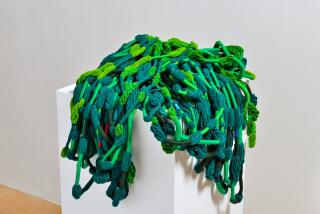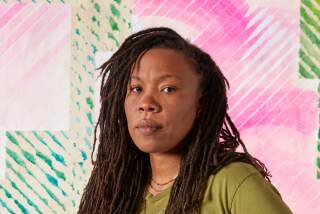AMBIGUOUS WAVES OF GRAIN : A Mix of Wheat and Chaff in Store in ‘Silo’
Remember those grainy black-and-white TV commercials of worried-looking people concerned about silos coming to their neighborhood? Some ill-advised advertising company capitalized on the military definition of the word (a silo is an underground structure for storing and launching a long-range ballistic missile) to draw attention to a chain of electronics stores.
An unsavory bit of business. But there’s no getting around the fact that the word silo packs a punch. Artist Barbara McCarren uses it as the title for her simple, open-endedly provocative installation at the Security Pacific Gallery.
The piece consists of a sensually seductive “field” of a couple thousand individual stalks of wheat waving slightly in the indoor air currents. The stem of each stalk is clad in copper wire and held upright in a metal vise grip.
Wispy cirrus clouds drift on a soft blue painted sky that surrounds three sides of the field. A pathway allows the viewer to walk into the field and momentarily experience the feeling of living the rural culture that defined Orange County in the not-so-distant past.
Of course, a silo also has a benign meaning relevant to farm life: a pit or tower in which green fodder is preserved. As the artist points out in a statement, other elements of the piece are also two-sided. Wheat, she reminds us, is both “the staff of life” and “a political bargaining chip” in international relations. Steel has great tensile strength, but in this case it is asked to do nothing more strenuous than hold a stalk of wheat in place.
All those shining new vise grips lying every which way on the floor are identical, as are the houses that make up the developments that keep pushing signs of nature deeper into the background here.
The transformation of Orange County’s farmland into high-rise developments was itself a two-edged phenomenon, resulting in a more active economy, vastly multiplied home values, a more heterogeneous population, greater cultural sophistication, loss of simple pleasures, increasing danger to the rural environment of plants and animals, a worship of materialism for its own sake . . .
But this is only one way to read the piece. McCarren herself clearly wishes to impose no single reading on it. She says, in an accompanying statement, that she makes installations because they resemble “those life experiences that engage a viewer’s total sensory apparatus,” and that “Silo” is intended to be “accessible to all viewers in some way.”
More to Read
The biggest entertainment stories
Get our big stories about Hollywood, film, television, music, arts, culture and more right in your inbox as soon as they publish.
You may occasionally receive promotional content from the Los Angeles Times.










